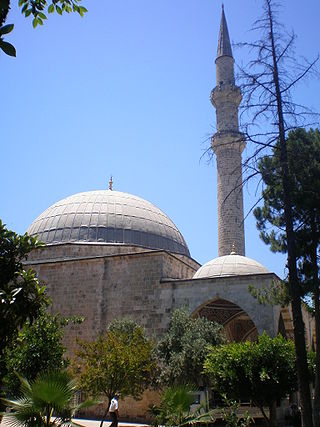Murat Pasha Mosque or Murad Pasha Mosque may refer to:
- Murat Pasha Mosque, Antalya, (built 1570) in Antalya, Turkey
- Murad Pasha Mosque, Damascus, (built 1568) in Damascus, Syria
- Murat Pasha Mosque, Aksaray, Istanbul
Murat Pasha Mosque or Murad Pasha Mosque may refer to:

Murad IV was the Sultan of the Ottoman Empire from 1623 to 1640, known both for restoring the authority of the state and for the brutality of his methods. Murad IV was born in Constantinople, the son of Sultan Ahmed I and Kösem Sultan. He was brought to power by a palace conspiracy when he was just 11 years old, and he succeeded his uncle Mustafa I. Until he assumed absolute power on 18 May 1632, the empire was ruled by his mother, Kösem Sultan, as nāʾib-i salṭanat (regent). His reign is most notable for the Ottoman–Safavid War, of which the outcome would partition the Caucasus between the two Imperial powers for around two centuries, while it also roughly laid the foundation for the current Turkey–Iran–Iraq borders.

Koca Sinan Pasha was an Albanian-born Ottoman Grand Vizier, military figure, and statesman. From 1580 until his death he served five times as Grand Vizier. In 1594, he ordered the burning of Saint Sava's remains on the Vračar plateau.
Sinan is a given name and surname.

Kuyucu Murad Pasha was an Ottoman Bosnian statesman who served as Grand Vizier of the Ottoman Empire during the reign of Ahmed I between December 9, 1606, and August 5, 1611. Maybe he was the fourth husband of Fatma Sultan, a daughter of Sultan Murad III. They married in 1611.
Omer Pasha Mosque was built by Ketendji Omer Pasha in 1602. It is located in Elmalı, Antalya Province, Turkey. The mosque, built entirely of cut stone, has a single dome. It reflects the classical Ottoman architecture. The mosque was built on a sloping area with a square plan. The mosque is the biggest Ottoman mosque in the Antalya area.

The Murat Paşa Mosque is an Ottoman mosque in the Muratpaşa borough of Antalya, Turkey.

The Sulaymaniyya Takiyya is a takiyya in Damascus, Syria, located on the right bank of the Barada River. Commissioned by the Ottoman sultan Suleiman the Magnificent, the western building of the complex was built, following the plans of Mimar Sinan, between 1554 and 1559. Another building was added eastwards from it in 1566 to be used as a madrasa.

The old city of Damascus is the historic city centre of Damascus, Syria. The old city, which is one of the oldest continuously inhabited cities in the world, contains numerous archaeological sites, including some historical churches and mosques. Many cultures have left their mark, especially Hellenistic, Roman, Byzantine and Islamic. In 1979, the historical center of the city, surrounded by walls of Roman era, was declared a World Heritage Site by UNESCO. In June 2013, UNESCO included all Syrian sites on the list of World Heritage in Danger to warn of the risks to which they are exposed because of the Syrian Civil War.
Sinan Pasha Mosque may refer to:
Şemsi Pasha, also known as Chamsi-Pasha, was a distinguished Ottoman nobleman and beylerbey who occupied several high-ranking posts, serving at various stages as the Ottoman governor-general of the beylerbeyliks of Damascus, Anatolia and Rumeli.

Melek Ahmed Pasha was an Ottoman statesman and grand vizier during the reign of Mehmed IV.

The Murad Pasha Mosque is an early Ottoman-era mosque and mausoleum in Damascus, Syria, located in the Suwayqa sector of the Al-Midan quarter. The mosque was erected and named after Murad Pasha, who served as the Ottoman governor ("wali") of Damascus between 1568-1569. The mosque was built in 1568. The mosque is also known as the Naqshbandi Mosque after the Naqshbandi sufi order which it served as a center for.
Kara Murat Pasha, or Kara Dev Murad Pasha, lit. Courageous Giant Murat Pasha in Ottoman Turkish;, was an Ottoman Albanian statesman and military officer. He served as Kapudan Pasha and twice as Grand Vizier. His epithet Kara ("black") refers to his courage and Dev ("giant") to his physical size.
Murat Pasha may refer to the following Ottoman statesmen:

Mehmed Rushdi Pasha was an Ottoman reformist and statesman. He served as Grand Vizier of the Ottoman Empire during five separate terms. He was preceded by Midhat Pasha. Mehmed Rushdi Pasha was a fervent supporter of the Tanzimat. He believed that the empire would lag behind the West if no attempt was made to modernize itself. He served as a Translator of Military texts as well as a military colonel in his youth. He was born in 1811, and died on 27 March 1882.

The Sultan Murad Mosque is an Ottoman-era mosque in Skopje, North Macedonia. It was built in the 15th century on top of the Monastery of Saint George which was destroyed when Ottoman commander Pasha Yiğit Bey captured Skopje from Vuk Branković in 1392.

The Murat Paşa Mosque is a 15th century Ottoman mosque squeezed in between two busy roads linking Aksaray and Yusufpaşa in the Fatih district of Istanbul, Turkey.
Yakub Çelebi was an Ottoman prince and the son of Murad I.

Şeytan Murad Pasha, also known as Kara Murad Pasha, was an Ottoman statesman. After serving stints as beylerbey of Lahsa, Basra and Shahrizor, he served as governor of Damascus in 1568–1570. He may have been the Murad ibn Abdullah, sanjak-bey of Pasin or Kayseri during the reign of Sultan Suleiman the Magnificent, credited by an inscription and the renovated the Haji Bektash Veli Complex.
Küçük Ahmed Pasha was an Ottoman military commander who twice served as beylerbey (governor-general) of Damascus, one term as beylerbey of Anatolia and died commanding troops against Safavid Iran. By eliminating the rebel Ilyas Pasha in Anatolia and the powerful Druze chief Fakhr al-Din in Mount Lebanon and his command role against the Safavids, Ahmed Pasha played an important part in the Ottoman imperial revival under Sultan Murad IV.